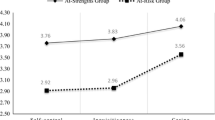Abstract
The objective of this study was to construct empowerment model through strength-based LEGO® SERIOUS PLAY® (LSP) workshop and to explore the effects and change connotations of this workshop. Two adult participants who had experienced domestic violence in childhood were invited to a 6-h strength-based LSP workshop. The research instruments included The Experiences in Close Relationships-Revised, Positive and Negative Affect Schedule, and Critical Positivity Ratio Self-Test Scale. They were employed on pretest, posttest, and follow-up test. Subsequently, group interview was conducted to explore the effectiveness of the strength-based LSP workshop. According to the research results, two participants exhibited a consistently increasing trend on their Critical Positivity Ratio Self-Test Scale. They demonstrated positive changing trend on the posttest involving attachment-related avoidance scale, and their scores on the attachment-related anxiety scale also presented an increasing trend. Furthermore, the textual information collected from the LegoViews revealed that the strength-based LSP workshop could ingrain inner strengths, develop strengths in a relationship, and reconstruct life experience.












Similar content being viewed by others
References
Bertini, P. (2013). Legoviews: A LEGO® SERIOUS PLAY®™ based interviewing technique. Paper presented at the LEGO® SERIOUS PLAY®™ Certified facilitators’ annual meeting, Billund. Retrieved from http://www.slideshare.net/patbertini/billund2.
Cascardi, M., O’Leary, K. D., & Schlee, K. A. (1999). Co-occurrence and correlates of posttraumatic stress disorder and major depression in physically abused women. Journal of Family Violence, 14(3), 227–249.
Cattannch, A. (2000). Working with children who have been subjected to violence. In H. Kemshall & J. Pritchard (Eds.), Good practice in working with victims of violence (pp. 62–74). Philadelphia, PA: Jessica Kingsley Publishers Ltd.
Cheng, J. A., & Liao, F. T. (2005). Research on the model of the recovery of the parent–child relationship between parents and physically abused children. Journal of Counseling & Guidance, 13, 1–38.
Fraley, R. C., Waller, N. G., & Brennan, K. A. (2000). An item-response theory analysis of self-report measures of adult attachment. Journal of Personality and Social Psychology, 78(2), 350–365.
Fredrickson, B. L. (2001). The role of positive emotions in positive psychology: The broaden and build theory of positive emotions. American Psychologist, 56(3), 218–226.
Fredrickson, B. L. (2009). Positivity. New York: Three Rivers Press.
Harn, P. L., Syu, T. R., Lin, W. L., Yang, L. H., Han, S. J., & Ni, J. N. (2016). Strength and empowerment card. Taipei: Psychological Publishing Co.
Kristiansen, P., & Rasmussen, R. (2014). Building a better business using the serious play method. New York: Wiley.
McGee, C. (2000). Children experiences of domestic violence. London: Jessica Kingsley.
Peabody, M. A. (2015). Building with purpose: Using LEGO SERIOUS PLAY in play therapy supervision. International Journal of Play Therapy, 24(1), 30–40.
Peterson, C., & Seligman, M. E. P. (2004). Character strengths and virtues: Handbook and classification. New York: Oxford University Press.
Seligman, M. E. P. (2002). Positive psychology, positive prevention, and positive therapy. In C. R. Snyder & S. J. Lopez (Eds.), Handbook of positive psychology (pp. 3–12). New York: Oxford University Press.
Smith, E. (2006). The strengths-based counseling model. The Counseling Psychologist, 34(1), 13–79.
Tyndall-Lind, A., Landreth, G. L., & Giordano, M. A. (2001). Intensive group play therapy with child witnesses of domestic violence. International Journal of Play Therapy, 10(1), 53–83.
Waldrop, A. E., & Resick, P. A. (2004). Coping among adult female victims of domestic violence. Journal of Family Violence, 19(3), 291–302.
Watson, D., Clark, L. A., & Tellegen, A. (1988). Development and validation of brief measures of positive and negative affect: The PANAS scales. Journal of Personality and Social Psychology, 54(6), 1063–1070.
Wong, Y. J. (2006). Strength-centered therapy: A social constructionist, virtues-based psychotherapy. Psychotherapy: Theory, Research, Practice, Training, 43(2), 133–146.
Wu, P. L. (2013). Crisis management and trauma therapy. Taipei: Pro-ED Publishing.
Author information
Authors and Affiliations
Corresponding author
Rights and permissions
About this article
Cite this article
Harn, P. A Preliminary Study of the Empowerment Effects of Strength-Based LEGO® SERIOUS PLAY® on Two Taiwanese Adult Survivors by Earlier Domestic Violence. Psychol Stud 62, 142–151 (2017). https://doi.org/10.1007/s12646-017-0400-3
Received:
Accepted:
Published:
Issue Date:
DOI: https://doi.org/10.1007/s12646-017-0400-3




